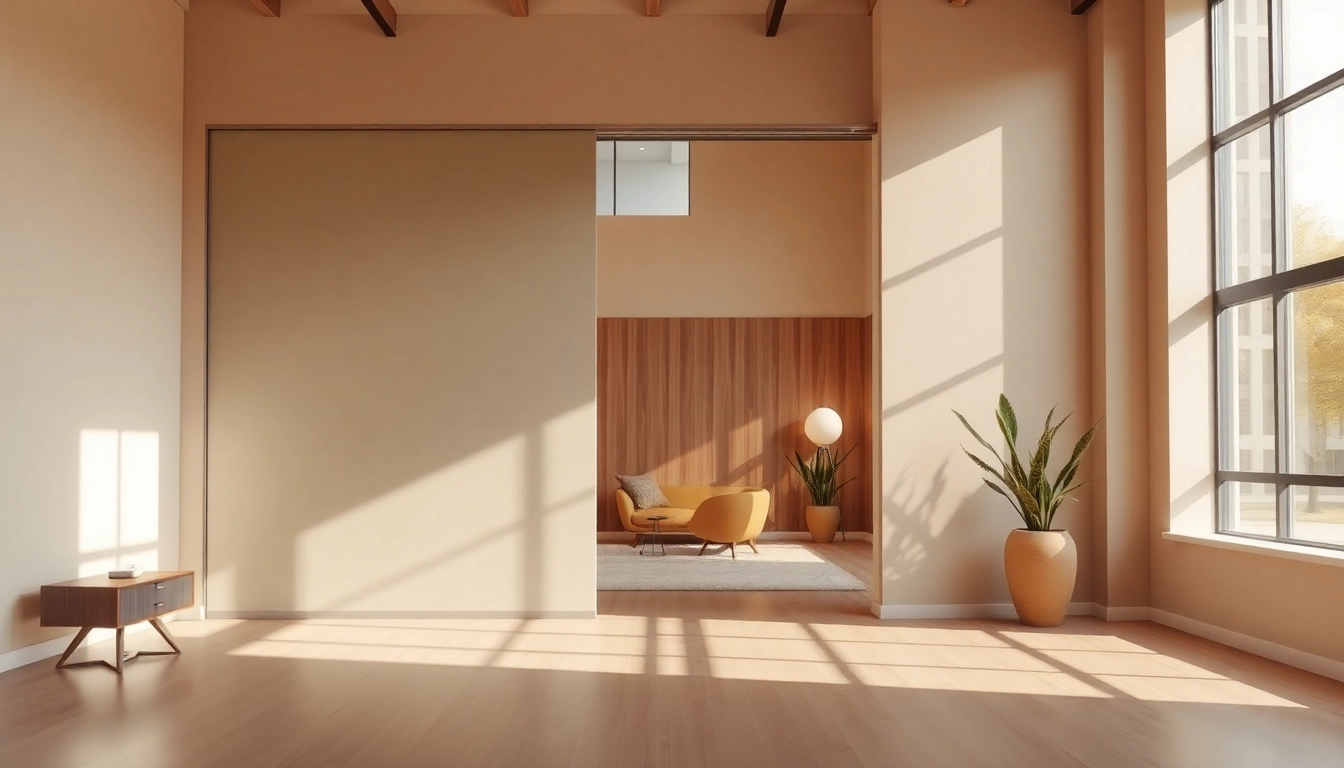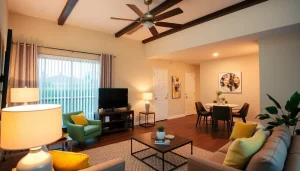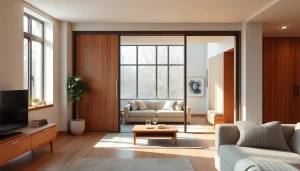Enhance Your Space with Stylish and Functional Sliding Partition Walls
Understanding Sliding Partition Walls
What is a Sliding Partition Wall?
A sliding partition wall is an innovative architectural solution used to create flexible and adaptable spaces within a building. Unlike traditional rigid walls, these partition walls can be slid open or closed, allowing for the reconfiguration of interior layouts without significant structural changes. Sliding partition walls are commonly employed in residential homes, offices, conference rooms, and other commercial spaces where the need for versatile space utilization is paramount.
These walls typically operate on a track system, either floor-mounted or ceiling-mounted, which enables smooth movement. They can be made from various materials, including wood, glass, fabric, or metal, depending on aesthetic requirements and functional needs.
Benefits of Using Sliding Partition Walls
Sliding partition walls offer several advantages for both residential and commercial applications. Some of the key benefits include:
- Space Optimization: Sliding walls allow for the effective use of space, transforming a large area into two or more smaller zones when needed. This capability is especially valuable in urban settings where square footage is limited.
- Flexibility: The adaptability of sliding walls enables users to customize the layout of their environments. Spaces can be quickly changed to suit various functions or activities without the need for alterations.
- Cost-Effective: Unlike the construction of permanent walls, which can be labor-intensive and expensive, sliding partition walls can often be installed with minimal disruption and at a lower overall cost.
- Improved Acoustics: Many sliding partition walls come with soundproofing options that minimize noise transfer between different areas, making them particularly useful for offices and conference rooms.
- Aesthetic Appeal: Available in a variety of finishes and materials, sliding walls can enhance the visual appeal of any space. They can serve as design focal points while maintaining functionality.
Different Types of Sliding Partition Walls
Several types of sliding partition walls cater to various needs and preferences. Some of the most popular variants include:
- Accordion or Folding Walls: These consist of multiple panels that fold in on themselves, creating a compact stack when opened. They are ideal for areas where floor space accommodates the storage of panels when not in use.
- Top-Hung Sliding Walls: Mounted on a ceiling track, these walls do not touch the floor, allowing for unobstructed movement and easy cleaning beneath. This design is particularly suitable for high-traffic areas.
- Glass Sliding Walls: These options offer transparency while still providing separation, making them perfect for maintaining an open feel while creating distinct spaces.
- Operable Walls: Often used in commercial settings, operable walls can be moved easily to create various room sizes. They typically feature soundproofing properties and are visually appealing.
Choosing the Right Sliding Partition Wall for Your Needs
Factors to Consider When Selecting a Sliding Partition Wall
Selecting the appropriate sliding partition wall requires careful consideration of several factors to ensure it meets your functional and aesthetic needs:
- Purpose: Determine the primary function of the sliding wall. Is it to separate spaces for privacy, acoustics, or aesthetic reasons? Knowing the purpose will guide your choice of material and design.
- Space Constraints: Evaluate the available space, including ceiling height and floor space. This analysis helps in choosing the wall type, as not every design fits in every setting.
- Acoustic Requirements: If noise reduction is a priority, opt for partition walls designed with soundproofing materials or features, like interlocking panels.
- Design Aesthetics: Consider how the wall will integrate with your existing decor. Various finishes, materials, and colors can enhance or detract from the overall design of the space.
- Budget: Establish a clear budget for this project, as the costs can significantly vary based on the design complexity and material used.
Material Options for Sliding Partition Walls
The materials selected for sliding partition walls significantly influence both their appearance and performance. Common material options include:
- Wood: Offers a warm, classic look, and is highly customizable with finishes and stains. Ideal for residential uses.
- Glass: Creates an airy feel and maintains visual transparency between spaces, perfect for modern offices or open-plan designs.
- Metal: Provides durability and a sleek, industrial aesthetic. It is often used in commercial spaces for longevity and versatility.
- Fabric: Typically used in areas requiring flexibility and sound absorption. Fabric panels can also serve as visual backdrops without being overly heavy.
Cost Considerations and Budgeting
Estimating the costs of a sliding partition wall involves several components:
- Material Costs: Depending on the type of material selected, costs can vary significantly. Wood typically costs less than glass or metal, which may require specialized installation.
- Installation Costs: Hiring professionals to install the partition can increase overall expenses. Evaluate whether a DIY approach is feasible while considering the complexity of the wall chosen.
- Long-Term Value: Investing in higher-quality materials may incur a larger upfront cost but can save money in the long run due to durability and reduced maintenance needs.
Installation Process for Sliding Partition Walls
Preparing Your Space for Installation
Preparation is crucial prior to installing a sliding partition wall. Key steps include:
- Measurements: Ensure accurate measurements of the area where the wall will be installed. This includes floor space, ceiling height, and the necessary track length.
- Clear Space: Remove any obstacles or furniture in the installation area to facilitate a smooth installation process.
- Structural Assessment: Check the soundness of walls and ceilings to support the weight of a sliding wall system, particularly with top-hung options.
DIY vs. Professional Installation
Choosing between DIY and professional installation largely depends on your skill level and the complexity of the wall system:
- DIY Installation: If you’re handy and choose a straightforward sliding partition, DIY installation can save money. Be sure to follow manufacturer instructions carefully.
- Professional Installation: For more complex systems or if you’re unsure about the installation process, hiring professionals can ensure proper setup and prevent costly mistakes.
Common Installation Challenges
During installation, several common challenges might arise, including:
- Incorrect Measurements: Double-check all measurements before cutting any materials to avoid mistakes that could lead to additional expenses.
- Weight Distribution: Ensure that the load-bearing structures are stable for heavy sliding walls, as improper anchoring can lead to safety hazards.
- Track Alignment: Misalignment of the track can impede smooth operation and cause wear on the sliding wall over time. Use a level to ensure proper placement.
Maintenance and Care for Sliding Partition Walls
Cleaning and Upkeep Tips
Regular maintenance ensures the longevity and functionality of sliding partition walls. Recommended steps include:
- Routine Cleaning: Regularly dust and wipe down surfaces with gentle cleaners appropriate for the material—avoiding harsh chemicals that may damage finishes.
- Track Maintenance: Inspect the tracks periodically for debris buildup that might impede movement. Clean and lubricate tracks as necessary to ensure smooth operation.
- Check Fastenings: Maintain stability by regularly checking and tightening screws and fastenings.
Signs Your Sliding Partition Wall Needs Repair
Signs that your sliding partition wall may require repair include:
- Difficulty in Movement: If the wall struggles to slide or gets stuck, it may indicate track issues or alignment problems.
- Visible Damage: Cracks or dents in the panels can become problematic over time, requiring replacement of the affected sections.
- Noise During Operation: Unusual sounds while sliding indicate potential issues with the bearings or track that need attention.
Upgrading Your Sliding Partition Wall
Upgrading can enhance functionality or aesthetics. Considerations for upgrades include:
- Material Replacement: Switching to a different material, such as glass for enhanced modern appeal, can significantly change the space’s ambiance.
- Automated Systems: Installing automatic sliding mechanisms can add convenience, particularly in commercial spaces.
- Design Enhancements: Adding decorative elements, such as artistic panels or custom finishes, can personalize the space further.
Inspiration and Design Ideas
Creative Ways to Incorporate Sliding Partition Walls
Sliding partition walls offer numerous opportunities for creativity and innovation within interior designs. Here are a few ideas:
- Home Offices: In today’s remote work environment, creating a designated workspace at home can improve productivity. Use sliding walls to separate a home office from living areas.
- Multi-Functional Rooms: In smaller apartments, using sliding walls can allow a single room, such as a studio, to serve multiple purposes (e.g., living and sleeping) by creating privacy when needed.
- Commercial Spaces: In office designs, sliding walls can create flexible meeting areas that are easily adapted for large groups or intimate discussions.
Case Studies: Successful Installations
A few notable examples highlight the versatility and effectiveness of sliding partition walls:
- Corporate Office Renovation: A technology company reconfigured its open-plan office using glass sliding walls to create conference rooms that could be opened up for larger gatherings.
- Restaurant Space: A downtown eatery incorporated wooden sliding walls to create private dining areas that can be adjusted depending on reservation sizes, enhancing the dining experience.
- Home Redesign: A family transformed a sprawling living room into distinct areas by using fabric sliding partitions, resulting in a more functional space while maintaining an open feel.
Trends in Sliding Partition Wall Design
Current trends in sliding partition wall design lean toward:
- Sustainability: Eco-friendly materials and designs that reduce waste and promote sustainability are becoming increasingly popular.
- Smart Technology Integration: More designs are incorporating technology such as automatic sensors or remote-operated mechanisms for ease of use.
- Minimalist Aesthetics: Clean lines, simple designs, and unobtrusive colors are key in modern decor, promoting a more spacious feeling.



